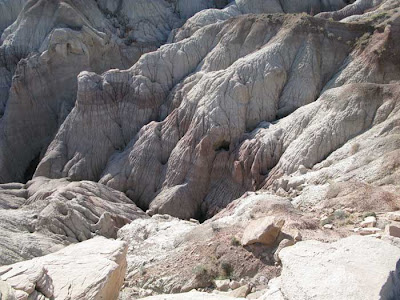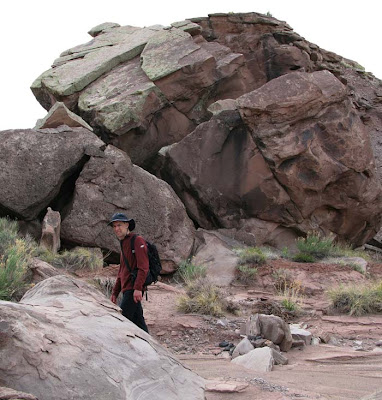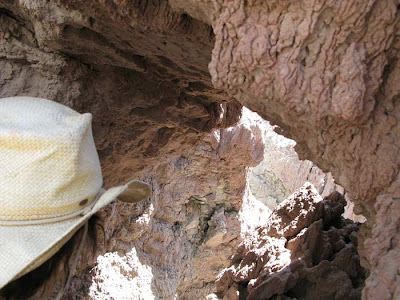 |
| Overlook on the Blue Mesa |
Because it's a long drive for people who aren't as fortunate as I to actually live in the park, it will take awhile for the first visitors to arrive. My first few hours are very quiet. Eventually I begin to hear car engines up above on the road, but no one has ventured down yet. So I'm confused when I hear what sounds like an engine, but a little too high pitched to be a car or even a motorcycle. And it doesn't sound like it is coming from the road above, it sounds like it's right near me, and then it's all around me — a swarm of locust, or perhaps they are mere grasshoppers, but I prepare myself for swatting them away or running. But after a split second of frenzied dark bodies animating the air around me they are gone, without touching me or my gear. It was a small swarm but caused so much momentary drama that I can't imagine what it would feel like to be in the midst of a miles-long locust invasion, especially when it meant losing everything you had cultivated.
 |
| Blue Mesa study, o/c |
I had noticed an unmarked pullout close to the south entrance station that provided access to an area called the Flattops. I decide to check it out. This area is the remains of a sandstone cap that once covered the area, now I can walk the edges where it has eroded to reveal the softer layer underneath. Under the sandstone ledge I find a little cave just big enough to sit in, and prop my paintbox on my lap. It is sheltered form the wind, but not the sun, so I set up my umbrella like a roof and am in my own little painting cocoon. The problem with finding a perfect set-up is that what feels great for the first half hour eventually becomes less so. This becomes very evident when my left leg falls asleep, and because my little cave is so cozy, I can't change my position very much. I manage to get a painting started anyway.
Although I often see footprints in the wilderness areas of the Petrified Forest I have never encountered another hiker, so I am confident that I can leave my pack just about anywhere and it will be waiting for me when I get back. So I leave my gear and my little cave and explored the rim with its huge tumbled down blocks of sandstone. The earth is soft here, and there are many holes in ground. There is also what appears to be a snake trail, so I tread carefully.
As I returned to my pack and hoist it on my back a small animal leaps from a bush and for a few moments I have no idea what it is. It is about the size of a small dog with huge ears. As it bounds away I realize it is a jackrabbit. There is no mistaking that for your average bunny.
Back home I find lizards on the patio and, leaving the door open as I bring in all my gear, one decides to invite himself in and run under the table. I chase him out and he scrambles over the flat rock and into a crevice in the stone wall.
I had thought about returning to the scene of my first painting below the PDI, but it was just a bit too late to get all set up down there, so after showering off the sunblock I work on my paintings till the light fades.























































